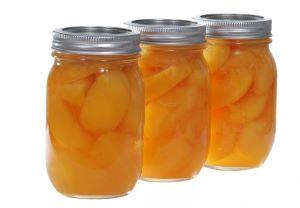Fruit can be safely frozen using different methods based upon the desired use of the final product. Although the use of sugar or syrup is not necessary to achieve a safe product, most fruit used for eating will have a better texture if frozen using a sugar or syrup pack. Fruits that are used for baking are best frozen using a sugar or dry pack.
Containers for Freezing
Using proper packaging material for freezing food is important to help protect flavor, color, moisture content, and nutritive value of the food.
In general, rigid containers, such as glass and plastic, are suitable for all packs, especially for liquid packs. Regular glass breaks easily at freezer temperatures. If using glass jars, choose wide mouth jars that are made for freezing. Some canning jars are made for freezing and canning. Freezer-grade plastic bags are good for dry packs with little to no liquid. If using plastic bags, press them to remove as much air as possible before closing.
General characteristics of packaging materials should be:
- Moisture vapor resistant.
- Durable and leakproof.
- Made of freezer grade material.
- Resistant to oil, grease, or water.
- Protect foods from absorption of off flavors or odors.
- Easy to seal - use freezer tape if needed to reinforce the seal.
- Easy to label and date.
- Containers that hold less than a one-half gallon.

Did You Know?
Dry-packed frozen berries can be used to make jam. Measure the amount of fruit needed prior to thawing. Thaw under refrigeration. When the fruit is almost thawed, immediately crush, measure and make the jam according to directions.
Apples
Select crisp apples. Wash, peel, and core. Slice medium apples into twelfths and large into sixteenths.
Select a pack method.
Syrup Pack - Use 40% cold syrup*. To prevent browning, add 1/2 tsp. (1500 mg) ascorbic acid to each quart of syrup. Start with 1/2 cup cold syrup in a pint container, add fruit, press fruit down and add syrup to cover. Crumple a small piece of water-resistant paper on top to hold fruit down.
Sugar Pack - To prevent darkening, dissolve 1/2 tsp. (1500 mg) ascorbic acid in 3 Tbsp. water. Sprinkle over fruit. You can also steam apple slices for 1 1/2 to 2 minutes. Cool and drain. Mix 1/2 cup sugar with 1 quart fruit.
Dry Pack - Follow directions for sugar pack, omitting the sugar. Treated apple slices can also be frozen on a tray then packed.
Package, leaving head space, seal, label, date, and freeze.
Blackberries
Wash gently in cold water, discarding soft, underripe or defective fruit.
Select a pack method.
Syrup Pack - Pack whole berries in a container and cover with a cold 40 - 50% syrup.
Sugar Pack - Mix 3/4 cup sugar with 1-quart berries.
Dry Pack - Pack into containers. Berries can also be frozen on a tray then packed.
Package, leaving head space, seal, label, date, and freeze.
Blueberries or Huckleberries
Select full-flavored, ripe berries. Remove leaves, stems and immature or defective berries. Do not wash. Washing results in a tougher skinned product.
Preparation - Select a pack method.
Dry Pack - Pack into containers, leaving head space. Berries can also be frozen on a tray, then packed. Seal, label, date, and freeze. Wash before using.
Cranberries
Choose firm, deep-red cranberries with glossy skins. Stem and sort. Wash and drain.
Preparation - Select a pack method.
Syrup Pack - For syrup pack, cover with cold 50% syrup, leaving head space. Seal, label, date, and freeze.
Dry Pack - Pack into containers, leaving head space2. Cranberries can also be frozen on a tray.
Peaches or Nectarines
Sort, wash, and peel. Be careful not to bruise the fruit.
Preparation - Select a pack method.
Syrup Pack - Use 40% syrup. To prevent darkening, add 1/2 tsp (1500 mg) ascorbic acid/quart syrup. Start with 1/2 cup cold syrup to a pint container, add fruit, press fruit down, add syrup to cover. Crumple a small piece of water-resistant paper on top to hold fruit down.
Sugar Pack - To each quart of prepared fruit (1 1/3 pounds) add 2/3 cup sugar and mix until dissolved or let stand 15 minutes. To stop darkening, add 1/4 tsp. (750 mg) ascorbic acid dissolved in 3 Tbsp. cold water to each quart fruit.
Package, leaving head space, seal, label, date and freeze.
Pears
Choose pears that are crisp and firm. Wash, peel, and core. Slice medium pears into twelfths and large into sixteenths.
Preparation - Select a pack method.
Syrup Pack - Heat pears in boiling 40% syrup for 1-2 minutes. Drain and cool. Pack pears and cover with cold 40% syrup. To stop darkening, add 3/4 tsp. (2250 mg) ascorbic acid to a quart of cold syrup. (Crumple a small piece of water-resistant paper to hold fruit down.)
Pack into container leaving head space. Seal, label, date, and freeze.
Raspberries
Sort berries using ripe, firm, and well-colored berries. Wash gently with cool water and drain.
Preparation - Select a pack method.
Syrup Pack - Pack berries into containers and cover with cold 40% syrup.
Sugar Pack - Mix 1-quart berries gently with 3/4 cup sugar.
Dry Pack - Pack berries into containers. Raspberries can also be frozen on a tray and then packed.
Package, leaving head space, seal, label, date, and freeze.
Rhubarb
Wash, trim, cut into lengths to fit package. To retain color and flavor, heat rhubarb in boiling water for 1 minute, cool quickly in cold water.
Preparation - Select a pack method.
Syrup Pack - Pack raw or pretreated rhubarb into containers, cover with cold 40% syrup.
Dry Pack - Pack raw or pretreated rhubarb into containers without sugar.
Pack leaving head space, seal, label, date, and freeze.
Strawberries
Select fully ripe, firm berries. Wash and sort. Hull, leave whole or slice.
Preparation - Select a pack method.
Syrup Pack - Place whole berries in container and cover with cold 50% syrup, leaving head space. Seal, label, date, and freeze.
Sugar Pack - Add 3/4 cup sugar to 1-quart whole strawberries and mix. Let stand for 15 minutes.
Package, leaving head space. Seal, label, date, and freeze.
Use the percentage of syrup indicated for each individual fruit.
| Type of Syrup | Sugar | Water |
|---|---|---|
| 10% (very light) | 1/2 cup | 4 cups |
| 20% (light) | 1 cup | 4 cups |
| 30% (medium) | 1 3/4 cups | 4 cups |
| 40% (heavy) | 2 3/4 cups | 4 cups |
| 50% (very heavy) | 4 cups | 4 cups |
Directions: Dissolve sugar in lukewarm water according to the chart; mix until dissolved. Chill syrup before using.
To Prevent Darkening : Light-colored fruits are kept from darkening during handling by the addition of ascorbic acid. Use either powdered ascorbic acid (available where food preservation supplies are sold) or crushed vitamin C tablets. Finely crush vitamin C tablets before use. Fillers in the tablets may make the syrup cloudy but it is not harmful.
Follow the directions below when adding ascorbic acid in various types of packs.
• In syrup or liquid packs - Add powdered or crushed ascorbic acid to cold syrup shortly before using. Stir it in gently so you do not stir in air. Keep the syrup refrigerated until use.
• In sugar or dry packs - Dissolve the ascorbic acid in two to three tablespoons of cold water and sprinkle the mixture over fruit just before adding sugar.

The use of sugar or syrup when freezing fruit is not necessary to achieve a safe product. Using sugar or syrup results in a better texture.
Head space allows for expansion of fruit during the freezing process.
| Pack Type | Container with Wide Top Opening | Container with Narrow Top Opening |
|---|---|---|
Liquid pack (fruit packed in sugar, syrup, or water; crushed or puree; juice) |
Quart - 1 inch |
Quart - 1 1/2 inches |
Dry pack (fruit packed without added sugar or liquid) |
Quart - 1/2 inch |
Quart - 1/2 inch |
Created: May 2006 , Updated: November 2023
Chart adapted from: The National Center for Home Food Preservation hosted by the University of Georgia Cooperative Extension. https://nchfp.uga.edu/#gsc.tab=0 and work completed by Catherine Violette, PhD. UNH Extension State Specialist, Food & Nutrition, Emeritus.
Updated by Ann Hamilton, UNH Extension Field Specialist, Food Safety
For more information on food preservation go to National Center for Home Food Preservation website - http://www.uga.edu/nchfp.
State Office
Taylor Hall
59 College Rd.
Durham, NH 03824
http://extension.unh.edu
Education Center and Information Line
answers@unh.edu
1-877-EXT-GROW
(1-877-398-4769)
9 am–2 pm M–F
